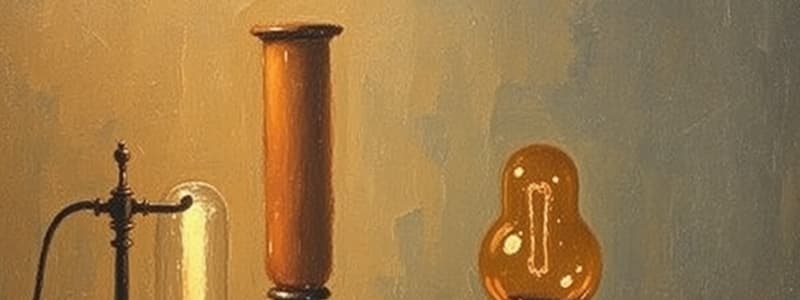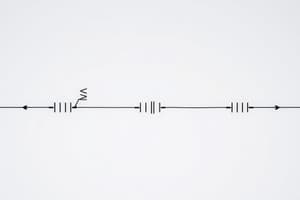Podcast
Questions and Answers
What does Ohm's Law state about the relationship between current and voltage in a conductor?
What does Ohm's Law state about the relationship between current and voltage in a conductor?
- Current is directly proportional to voltage. (correct)
- Current equals the square of voltage.
- Current is inversely proportional to voltage.
- Current is dependent on resistance alone.
What is the formula used to calculate resistance according to Ohm's Law?
What is the formula used to calculate resistance according to Ohm's Law?
- R = V/I (correct)
- R = V * I
- R = V + I
- R = I/V
Which of the following statements is NOT a limitation of Ohm's Law?
Which of the following statements is NOT a limitation of Ohm's Law?
- Ohm's law is valid under constant physical conditions. (correct)
- Ohm's law cannot be applied to Non-Linear circuits.
- Ohm's law cannot be applied at very high temperatures.
- Ohm's law cannot be applied to Uni-Lateral circuits.
What are the units of measurement for voltage, current, and resistance?
What are the units of measurement for voltage, current, and resistance?
In the experimental setup to verify Ohm's Law, what is the role of the potentiometer?
In the experimental setup to verify Ohm's Law, what is the role of the potentiometer?
Which observation indicates that Ohm's Law has been successfully verified?
Which observation indicates that Ohm's Law has been successfully verified?
What is the purpose of the wire wound resistor in the experiment?
What is the purpose of the wire wound resistor in the experiment?
Why is it important to record the readings carefully during the experiment?
Why is it important to record the readings carefully during the experiment?
How would you calculate the minimum operating voltage for the fluorescent light in the provided circuit setup?
How would you calculate the minimum operating voltage for the fluorescent light in the provided circuit setup?
What method can be used to determine the current drawn by the fluorescent light during the experiment?
What method can be used to determine the current drawn by the fluorescent light during the experiment?
In the context of the experiment, how can you calculate the power consumed by the fluorescent light?
In the context of the experiment, how can you calculate the power consumed by the fluorescent light?
What role does the power factor play in examining the fluorescent light's efficiency?
What role does the power factor play in examining the fluorescent light's efficiency?
Describe how to measure the output voltage across the fluorescent light during the experiment.
Describe how to measure the output voltage across the fluorescent light during the experiment.
What precautions should you take while measuring the current and voltage in the circuit?
What precautions should you take while measuring the current and voltage in the circuit?
How does the configuration of the circuit affect the readings of current and voltage?
How does the configuration of the circuit affect the readings of current and voltage?
Explain the significance of taking multiple readings during the experiment.
Explain the significance of taking multiple readings during the experiment.
How can the minimum operating voltage of the circuit be determined during the experiment?
How can the minimum operating voltage of the circuit be determined during the experiment?
What is meant by the current drawn in the context of the experiment, and how is it measured?
What is meant by the current drawn in the context of the experiment, and how is it measured?
Explain how to calculate the power consumed by the fluorescent light during the experiment.
Explain how to calculate the power consumed by the fluorescent light during the experiment.
What role does the power factor play in evaluating the performance of the fluorescent light?
What role does the power factor play in evaluating the performance of the fluorescent light?
Describe how changing the resistance in the circuit impacts the current drawn.
Describe how changing the resistance in the circuit impacts the current drawn.
What is the significance of the resonant frequency in an AC circuit?
What is the significance of the resonant frequency in an AC circuit?
How does temperature affect the resistance of the wire wound resistor used in the experiment?
How does temperature affect the resistance of the wire wound resistor used in the experiment?
What observations would indicate a deviation from Ohm's Law during the experiment?
What observations would indicate a deviation from Ohm's Law during the experiment?
How is the quality factor (Q) defined in the context of a tuned circuit?
How is the quality factor (Q) defined in the context of a tuned circuit?
In the context of the experiment, why is it important to measure both voltage and current accurately?
In the context of the experiment, why is it important to measure both voltage and current accurately?
What happens to the current in the circuit when the frequency exceeds the resonant frequency?
What happens to the current in the circuit when the frequency exceeds the resonant frequency?
What components are typically involved in a tuned circuit?
What components are typically involved in a tuned circuit?
What is the formula for calculating the resonant frequency of a tuned circuit?
What is the formula for calculating the resonant frequency of a tuned circuit?
Why is it necessary to measure the minimum operating voltage during the experiment?
Why is it necessary to measure the minimum operating voltage during the experiment?
What is the purpose of the sine wave oscillator in the experimental setup?
What is the purpose of the sine wave oscillator in the experimental setup?
How does the current drawn by the circuit vary with frequency around the resonant frequency?
How does the current drawn by the circuit vary with frequency around the resonant frequency?
Flashcards
Ohm's Law
Ohm's Law
Under constant physical conditions (temperature, pressure, humidity), the current through a conductor is directly proportional to the voltage across it.
Resistance
Resistance
Opposition to current flow in a conductor, measured in ohms.
Ohm's Law Formula
Ohm's Law Formula
V = IR, where V is voltage, I is current, and R is resistance.
Limitations of Ohm's Law
Limitations of Ohm's Law
Signup and view all the flashcards
Non-linear Circuits
Non-linear Circuits
Signup and view all the flashcards
Uni-lateral Circuits
Uni-lateral Circuits
Signup and view all the flashcards
Verifying Ohm's Law
Verifying Ohm's Law
Signup and view all the flashcards
Experimental Procedure
Experimental Procedure
Signup and view all the flashcards
Voltage Measurement
Voltage Measurement
Signup and view all the flashcards
Series Connection
Series Connection
Signup and view all the flashcards
Parallel Connection
Parallel Connection
Signup and view all the flashcards
Short Circuit
Short Circuit
Signup and view all the flashcards
Open Circuit
Open Circuit
Signup and view all the flashcards
Measuring Current
Measuring Current
Signup and view all the flashcards
Calculating Voltage
Calculating Voltage
Signup and view all the flashcards
Resonant Frequency
Resonant Frequency
Signup and view all the flashcards
Tuned Amplifier
Tuned Amplifier
Signup and view all the flashcards
Tank Circuit
Tank Circuit
Signup and view all the flashcards
Quality Factor (Q)
Quality Factor (Q)
Signup and view all the flashcards
Series Resonance
Series Resonance
Signup and view all the flashcards
What is the formula for calculating the resonant frequency?
What is the formula for calculating the resonant frequency?
Signup and view all the flashcards
What happens to current as the frequency approaches the resonant frequency?
What happens to current as the frequency approaches the resonant frequency?
Signup and view all the flashcards
What is the role of the sine wave oscillator in the experiment?
What is the role of the sine wave oscillator in the experiment?
Signup and view all the flashcards
Direct Proportionality
Direct Proportionality
Signup and view all the flashcards
What is the importance of constant physical conditions?
What is the importance of constant physical conditions?
Signup and view all the flashcards
How to measure resistance?
How to measure resistance?
Signup and view all the flashcards
What does a V vs I graph show?
What does a V vs I graph show?
Signup and view all the flashcards
What is the purpose of the potentiometer?
What is the purpose of the potentiometer?
Signup and view all the flashcards
What is the role of the resistor in the experiment?
What is the role of the resistor in the experiment?
Signup and view all the flashcards
Study Notes
Ohm's Law Experiment
-
Objective: Verify Ohm's Law using graphical results.
-
Apparatus: Two analog meters (for voltage and current), potentiometer, 10Ω wire wound resistor.
Theory and Formula
-
Ohm's Law: Under constant temperature, pressure, and humidity, current is directly proportional to voltage across a conductor.
-
Formula: V = IR (where V is voltage, I is current, and R is resistance)
Experimental Procedure
- Connect the 10Ω resistor.
- Turn the piano switch on.
- Vary the voltage (using the potentiometer) and record corresponding current and voltage values.
- Calculate resistance (R = V/I) for different voltage and current readings.
- Compare observed and calculated resistance values.
- Plot a graph of voltage (V) vs. current (I).
Limitations of Ohm's Law
- Non-linear circuits: Ohm's Law does not apply to them.
- Uni-lateral circuits: Ohm's Law does not apply to them.
Observations and Calculations
- Record voltage (V) and current (I) measurements.
- Calculate resistance (R) for each data point using the formula.
Results
- Ohm's Law verified. (A straight-line graph supports this)
Conclusions
- A straight line graph demonstrates the linear relationship, proving Ohm's Law.
Viva Voce Questions
- Ohm's Law Definition: Current is directly proportional to voltage under constant conditions.
- Limitations: Non-linear and uni-lateral circuits.
- EMF vs. Potential Difference: EMF is the potential difference in an un-connected circuit, while Potential Difference is measured across.
- Units: Voltage (Volts), Current (Amps), Resistance (Ohms).
- Linear vs. Non-Linear Circuits: Linear circuits have a constant resistance; non-linear circuits don't.
- Uni-lateral vs. Bi-lateral Circuits: Uni-lateral circuits only allow current to flow in one direction; bi-lateral circuits allow current in both directions.
- Ammeter and Voltmeter Connection: Ammeters are connected in series; voltmeters are connected in parallel.
- Rheostat Material: Typically a wire-wound resistor.
- Temperature and Resistance: Temperature usually increases resistance.
Studying That Suits You
Use AI to generate personalized quizzes and flashcards to suit your learning preferences.



